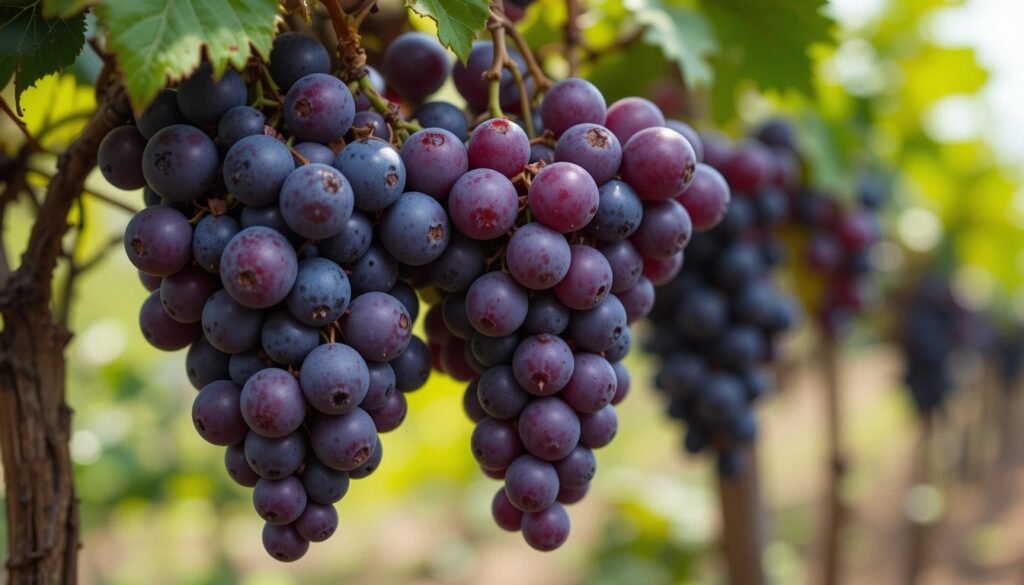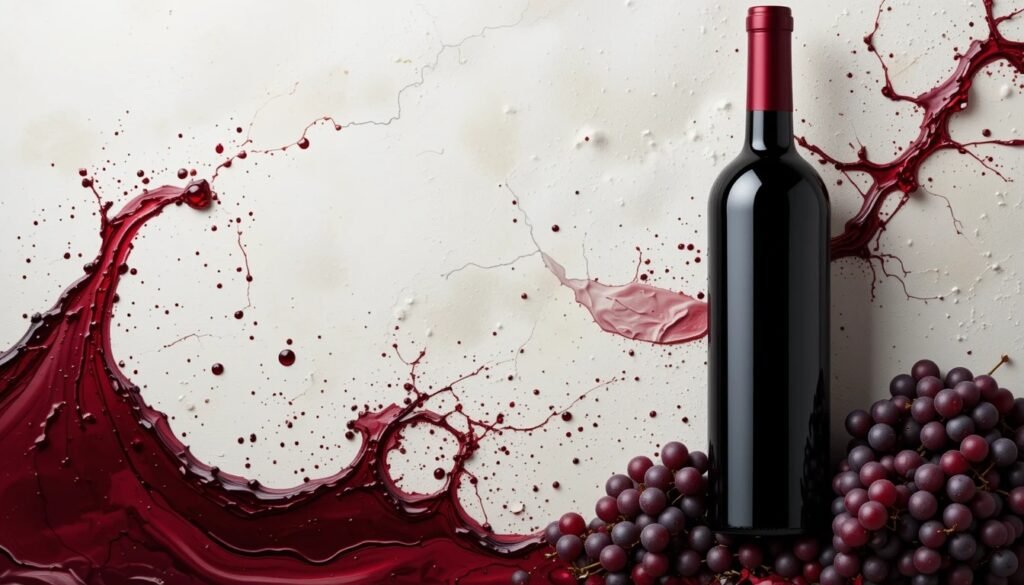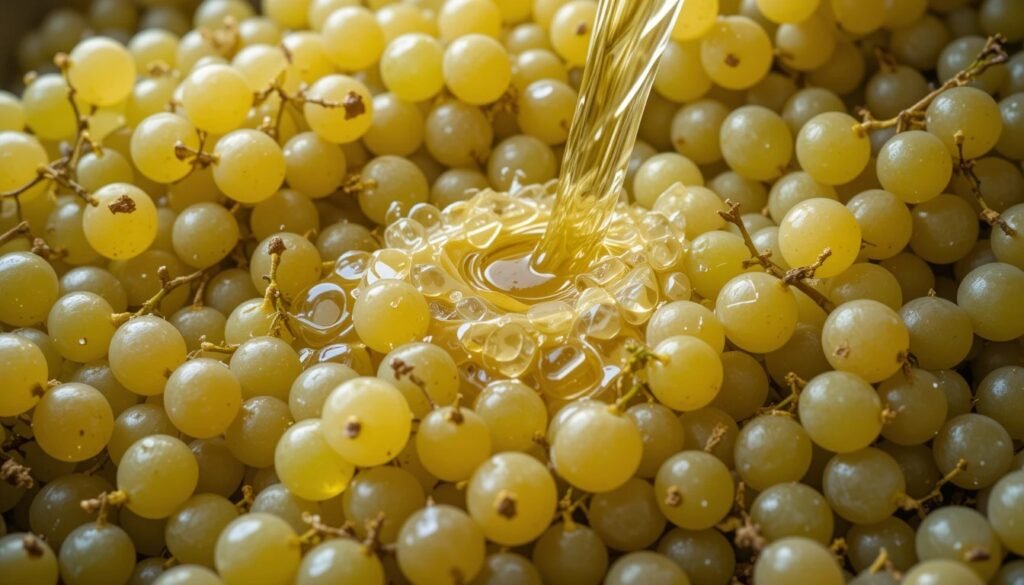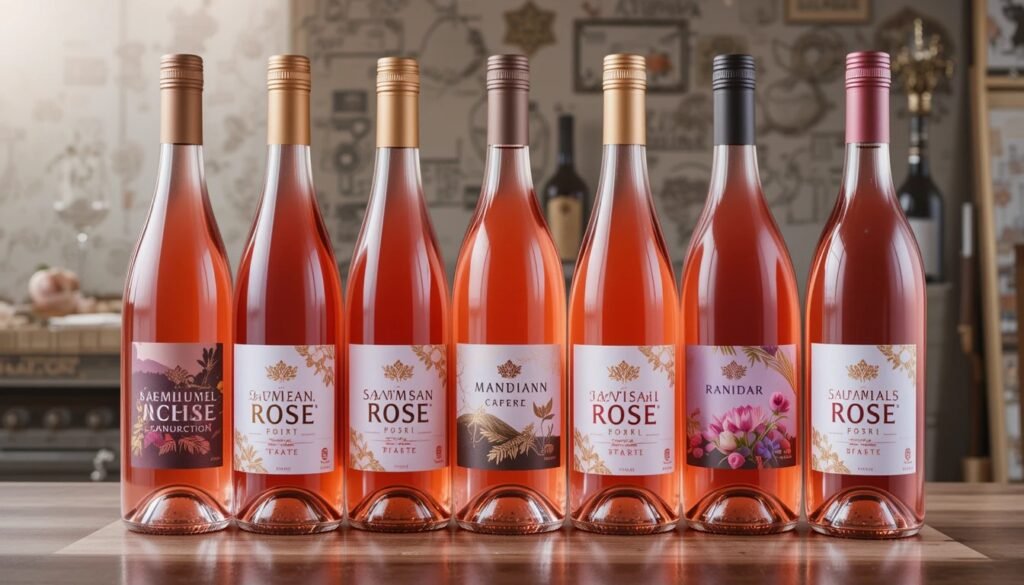
Introduction to Wine Varieties
Wine is a complex and diverse beverage that has been enjoyed for centuries across cultures and geographies. At its core, wine can be categorized into three main varieties: red, white, and rosé. Each type is characterized by unique characteristics that arise from the grape varieties used, the fermentation processes undertaken, and the resulting flavor profiles that emerge.
Red wine is typically produced from dark-colored grape varieties. The key feature that distinguishes red wine is the inclusion of the grape skins during fermentation. This process not only imparts the rich color but also contributes to the tannins and various flavor compounds found in the finished product. Common grape types used for red wines include Cabernet Sauvignon, Merlot, and Pinot Noir, each offering distinct flavor profiles ranging from bold and fruity to complex and earthy.
On the other hand, white wine is produced primarily from green or yellowish grapes. In this fermentation process, the grape skins are usually removed, leading to a lighter color and a fresher palate. Popular varieties of grapes used in white winemaking include Chardonnay, Sauvignon Blanc, and Riesling. These wines tend to exhibit bright acidity and fruit-forward flavors, making them versatile to pair with a variety of dishes.
Rosé wine occupies a unique position by leveraging techniques from both red and white winemaking. It is often made from red grape varieties, with the skins remaining in contact with the juice for only a short period, resulting in a pink hue. The flavor profile of rosé can range from dry to sweet, often striking a balance between the bold characteristics of red wine and the refreshing qualities of white. This makes rosé an appealing choice for many, especially in warmer climates.

Understanding the fundamental differences between these wine varieties enhances one’s appreciation for wine and facilitates informed choices in pairings and preferences. Each type of wine offers its own benefits and charm, inviting enthusiasts and casual drinkers alike to explore the intricate world of viticulture.
What is Red Wine?
Red wine is a type of wine made from dark-colored grape varieties. The color of red wine can range from deep violet to pale ruby, depending on the grape varieties used, the production techniques employed, and the aging processes applied. The production of red wine primarily involves fermenting the grapes along with their skins, which contributes to the wine’s flavor, color, and tannin structure. This fermentation method, known as maceration, is essential for extracting the rich pigments and complex compounds that characterize red wines.

Some of the most renowned grape varieties for red wine include Cabernet Sauvignon, Merlot, Pinot Noir, and Syrah. Each of these grapes offers distinct flavor profiles; for instance, Cabernet Sauvignon is often described as bold and full-bodied, with notes of dark fruit, green pepper, and sometimes, tobacco. In contrast, Merlot typically presents a softer, more fruity profile with prevalent flavors of plum and cherry.
The flavors and aromas of red wine can be influenced by numerous factors, including the region in which the grapes are grown, the climate, and the winemaking techniques used. Terroir, a French term, underscores the significant impact of the natural environment, including soil composition and climate, on the grapes’ characteristics and, subsequently, the resulting wine. This complexity makes red wine a nuanced beverage that can appeal to a diverse range of palates.

Moreover, red wine is often associated with several health benefits, particularly when consumed in moderation. Research has suggested that moderate consumption may support heart health, attributed to the presence of antioxidants such as resveratrol and flavonoids. These compounds are believed to help improve heart function and lower the risk of heart disease by reducing inflammation and improving circulation. Expert opinions generally concur that when enjoyed responsibly, red wine can be part of a healthy lifestyle.
What is White Wine?
White wine is a type of wine made primarily from green or yellowish grapes. The production process for white wine typically involves both the fermentation of the grape juice and, in some cases, the skin. To create the crisp and refreshing taste that is characteristic of many white wine varieties, winemakers usually separate the grape juice from the skins immediately after crushing. This method helps preserve the light color and allows the delicate flavors to emerge. The fermentation process requires careful monitoring of temperature, with cooler temperatures promoting a more fruit-forward profile.

Chardonnay and Sauvignon Blanc are two of the most widely recognized grape varieties used in white wine production. Chardonnay can exhibit a range of flavors, from citrus and apple to tropical fruits, depending on the climate where it is grown and the winemaking techniques employed. Sauvignon Blanc, on the other hand, is known for its zesty acidity and aromatic notes that can include lime, green apple, and passion fruit. Both of these grape varieties are versatile and can be crafted into various styles of white wine, from dry and light to rich and buttery.

Beyond its delightful taste, moderate consumption of white wine has been linked to several health benefits. Research suggests that white wine may help improve cholesterol levels, leading to better heart health. Moreover, certain compounds found in white wine, such as polyphenols, are thought to possess anti-inflammatory properties that could contribute to overall well-being. However, it is essential to approach wine consumption with moderation, as excessive intake can negate these benefits. Ultimately, white wine offers not only a range of flavors but also potential health advantages when enjoyed responsibly.
What is Rosé Wine?
Rosé wine, a unique and versatile beverage, combines characteristics of both red and white wines, offering a delightful experience for wine enthusiasts. This type of wine is typically made from red grape varieties, where the skins are allowed to remain in contact with the juice for a limited time during fermentation. The result is a spectrum of hues ranging from pale pink to vibrant fuchsia, influenced by the grape type, skin contact duration, and the winemaking technique applied.
There are several methods employed to produce rosé wine. One common approach is the skin contact method, which involves pressing the grapes and allowing the juice to macerate with the grape skins for a short period. This technique imparts color and flavor without the intensity associated with red wines. Another method is blending, where a winemaker combines red and white wines to achieve the desired color and taste. Each method results in distinctive flavor profiles, showcasing the creativity and skill of the winemaker.

The flavor profiles of rosé wines can vary dramatically, with popular options such as dry, sweet, or sparkling variants. Dry rosés are characterized by crisp acidity and refreshing fruit notes, often featuring flavors like strawberry, raspberry, and watermelon. In contrast, sweeter rosés may offer a more tropical fruit palette, including flavors like peach and apricot. Sparkling rosés add an effervescent quality while enhancing the overall taste experience.
One notable benefit of rosé wine is its higher acidity compared to its red and white counterparts, making it a hydrating option that is often enjoyed during warm weather. Additionally, rosé generally tends to have a lower calorie count, making it a preferred choice for those who are health-conscious while still wishing to indulge in a delightful glass of wine. Its balanced charm and versatility have led to an increase in popularity, solidifying rosé’s place in the world of wine.
Health Benefits of Wine Consumption
Moderate wine consumption, encompassing red, white, and rosé varieties, has garnered attention for its potential health benefits. Numerous studies suggest that the compounds found in wine, particularly red wine, may contribute to improved overall health and longevity. One of the key components attributed to these benefits is resveratrol, a polyphenolic compound primarily present in the skins of grapes. Resveratrol is known for its antioxidant properties, which may help combat oxidative stress in the body, a factor linked to various chronic diseases.
In addition to resveratrol, both red and white wines contain a range of other polyphenols that have been associated with cardiovascular health. Regular, moderate wine consumption has been linked to increased levels of high-density lipoprotein (HDL) cholesterol—often referred to as “good” cholesterol—which is crucial for heart health. Moreover, polyphenols may improve endothelial function, leading to improved circulation and a decreased risk of heart disease.

Psychological well-being is another area where moderate wine consumption shows promise. Some research supports the idea that the ritual of having a glass of wine can serve as a social lubricant, promoting relaxation and enhancing one’s mood. This aspect may contribute to improved mental health, particularly in social settings where wine is enjoyed among friends or family. Additionally, certain studies indicate that moderate drinking could be linked with lower rates of anxiety and depression.
Ultimately, it’s important to note that the health benefits of wine consumption are most pronounced when intake is moderate. Excessive alcohol consumption can lead to a myriad of health issues, including liver disease and dependency. Therefore, understanding the balance between enjoying the potential advantages and avoiding the risks is crucial for those seeking to incorporate wine into their lifestyle.
Comparison Table of Alcohol Percentage
Understanding the alcohol by volume (ABV) percentages is essential for wine enthusiasts as it plays a significant role in the flavor profile, mouthfeel, and overall drinking experience. The typical ABV levels vary among red, white, and rosé wines, with each category offering unique characteristics stemming from their alcohol content.
Red wines generally exhibit the highest ABV levels, typically ranging from 13% to 15%. This higher alcohol content often results in a more robust flavor and a fuller body, which can enhance the rich, complex notes found in many red varieties. Wines such as Cabernet Sauvignon or Syrah are prime examples of this category, where higher alcohol levels contribute to their intense aromatic and flavor profiles.
Here’s the extracted numerical data from the paragraph in a table format 🍷
| Wine Type | ABV Range (%) |
|---|---|
| Red Wine | 13% – 15% |
| White Wine | 11% – 14% |
| Rosé Wine | 12% – 14% |
In contrast, white wines tend to have a lower ABV, generally falling between 11% and 14%. This slight reduction in alcohol can lead to a lighter, crisper beverage that allows the fruity and floral notes to shine. For instance, a Sauvignon Blanc or Pinot Grigio is likely to have a more refreshing character due to their lower alcohol levels, making them popular choices for warmer climates or casual gatherings.
Rosé wines typically exhibit ABV levels that bridge the gap between red and white wines, usually ranging from 12% to 14%. These wines are known for their versatility, offering a spectrum of flavors that can appeal to a wide variety of palates. The moderate alcohol content in rosés often leads to a balanced experience that highlights both fruitiness and acidity.
In summary, the ABV levels of red, white, and rosé wines greatly influence the flavor intensity and drinking experience. Understanding these differences can help consumers make informed choices about which type of wine complements their preferences and occasions best.
Pairing Food with Different Wine Types
Wine pairing is a crucial element that amplifies the dining experience, enhancing both the food and the wine. Understanding the nuances between red, white, and rosé wines allows for more thoughtful food selections. Traditionally, red wines pair beautifully with rich, hearty dishes. Classic combinations include roasted red meats, such as beef and lamb, as well as robust pastas featuring tomato-based sauces. The tannins present in red wine complement the protein and fat in these dishes, creating a pleasing balance on the palate.
On the other hand, white wines are often favored for lighter fare. These wines, which tend to be crisper and more acidic, are well-suited to seafood, poultry, and vegetable dishes. For instance, a Chardonnay pairs nicely with grilled salmon, while a Sauvignon Blanc enhances the flavors of a fresh garden salad. The acidity of white wines helps to cut through the richness of the food, offering a refreshing contrast that elevates the entire meal.

Rosé wines, with their versatility and fruity notes, have gained modern popularity as a perfect pairing for a range of cuisines. Their light body allows them to complement everything from charcuterie boards filled with cured meats and cheeses to spicy Asian dishes. The balanced nature of rosé makes it a delightful companion for both casual barbecues and elegant dinners, bridging the gap between red and white pairings.
Ultimately, the art of pairing food with wine is about achieving harmony. The right wine not only enhances the flavors of a dish but also creates a memorable dining experience. By considering the characteristics of each wine type, one can thoughtfully select pairings that delight the senses and elevate the overall gastronomic experience. As the saying goes, “what grows together goes together,” guiding consumers in their pursuit of perfect wine and food duos.
Cultural Importance and Occasions
Wine holds a profound cultural significance across various societies, serving as a symbol of celebration, hospitality, and communal bonding. In many countries, the ritual of sharing a bottle of wine fosters connections among individuals, enhancing social interactions during gatherings and celebrations. Red, white, and rosé wines each play a unique role in distinct cultural traditions and events.
In Mediterranean cultures, for instance, wine is often integral to communal meals and family gatherings. Red wines are traditionally paired with hearty dishes, like roasted meats and stews, while white wines complement lighter fare such as seafood and salads. In these contexts, the act of toasting with a glass of wine symbolizes unity and a shared appreciation for culinary traditions. Similarly, in many Asian cultures, wine is increasingly becoming part of celebrations, where it is used in toasts during significant events such as weddings and festivals. The choice of wine, whether red, white, or rosé, may reflect the nature of the occasion.

Moreover, wine plays a significant role in religious and cultural ceremonies worldwide. For instance, in Christianity, wine represents the blood of Christ during Eucharist, while in Jewish traditions, it is customary to include wine during celebratory meals such as Passover. In these instances, the quality and type of wine chosen for the occasion can enhance the spiritual and emotional atmosphere, demonstrating the importance of wine in cultural contexts.
Notably, rosé wine has gained prominence in contemporary gatherings, being associated with leisurely summer afternoons and casual celebrations. It often represents a lighter, more casual approach to wine consumption, ideal for outdoor events and social mingling. Overall, wine, regardless of its type, meticulously intertwines with cultural practices, enhancing the communal experience and underscoring the importance of shared moments across different societies.

Conclusion: Choosing the Right Wine for You
When it comes to selecting a wine, understanding the differences between red, white, and rosé options is essential. Each type of wine offers distinct flavors and characteristics that can enhance your dining experience. Red wine, known for its rich tannins and bold flavors, is often associated with health benefits due to its high levels of antioxidants. In contrast, white wine typically features lighter, crisper flavors that can complement seafood and poultry dishes. Rosé, with its unique blending of characteristics from both red and white wines, provides a versatile option for various occasions.
Personal preferences play a significant role in wine selection. Some individuals may gravitate towards the depth and complexity of red wines, while others may prefer the refreshing lightness of white or rosé wines. To determine your ideal choice, consider the occasion: red wines are often ideal for formal dinners, white wines are perfect for warm-weather gatherings, and rosé wines can seamlessly fit into casual settings. Additionally, the flavor profiles of each wine can pair beautifully with different types of cuisine, enhancing not only the meal but also the overall experience.

It is important to consider health considerations, as moderation is key when consuming alcohol. Understanding the alcohol content of your chosen wine can help in making informed decisions. As a general guideline, red wines typically have higher alcohol content, while white and rosé wines often contain less. This knowledge allows for enjoyable consumption without compromising health. Remember to explore a variety of options, as discovering new wines can be a delightful journey. Enjoy wine responsibly to maximize its benefits while savoring the unique qualities each type has to offer.

Great work on this insightful post. Your style is engaging and the ideas are well-articulated. Looking forward to more posts.
Wine is truly a fascinating subject, isn’t it? The way it’s categorized into red, white, and rosé shows how diverse and intricate winemaking can be. I’ve always been curious about how the fermentation process affects the final flavor—do you think the grape skins’ inclusion in red wine is what makes it so rich and complex? Personally, I lean towards white wines for their refreshing and versatile nature, but I’ve been wanting to explore more rosé options. What’s your go-to wine for a summer evening? Also, do you think the popularity of rosé is just a trend, or does it genuinely offer something unique compared to red and white? I’d love to hear your thoughts on this!
Wine is truly a fascinating subject, isn’t it? The way it’s crafted and the diversity it offers is remarkable. I’ve always been curious about how the fermentation process can create such distinct flavors and aromas. For instance, why do red wines tend to have more tannins compared to whites? Is it solely because of the grape skins, or are there other factors at play? I also wonder if the climate and soil where the grapes are grown have a significant impact on the final product. Rosé seems like the perfect middle ground—light yet flavorful. Do you think it’s underrated compared to reds and whites? I’d love to hear your thoughts on which type of wine you think pairs best with different cuisines. Cheers to exploring the world of wine! 🍷
Wine is truly a fascinating subject, isn’t it? The way it’s categorized into red, white, and rosé shows how diverse and intricate winemaking can be. I’ve always been curious about how the fermentation process affects the final flavor—do you think the grape skins are the most important factor? Personally, I find red wines like Cabernet Sauvignon to be so rich and complex, but I also love the crispness of a good Sauvignon Blanc. Rosé seems like the perfect middle ground, especially for summer. What’s your favorite type of wine and why? I’d love to hear your thoughts on what makes a wine truly stand out for you.
Wine has always fascinated me with its rich history and diversity. It’s amazing how something as simple as grapes can transform into such complex and varied beverages. I particularly enjoy how red wines offer bold, earthy flavors, while white wines bring a refreshing, crisp taste. Rosé seems to be the perfect middle ground, combining the best of both worlds. Do you think the choice of grape variety or the fermentation process plays a bigger role in defining a wine’s character? I’d love to hear your thoughts on which type of wine pairs best with different cuisines. Personally, I find that a good red wine enhances the flavors of hearty dishes, but I’m curious if others feel the same. What’s your go-to wine for a summer evening?
Wine is such a fascinating topic, especially when you dive into the differences between red, white, and rosé. I’ve always been drawn to red wines for their bold flavors and complexity, especially Cabernet Sauvignon. White wines, on the other hand, seem so refreshing and versatile—perfect for summer evenings. Rosé is a great middle ground, offering something light yet still flavorful. It’s interesting how much the grape varieties and fermentation processes shape the final product. Do you think the choice of grape is more important than the winemaking technique? I’d love to hear your thoughts on what makes a wine truly stand out.
Wine is truly a fascinating subject with so much depth and variety. It’s incredible how something as simple as grape juice can transform into such a complex beverage with distinct flavors and colors. Red wine, with its bold tannins and rich profiles, always feels so robust and full-bodied, while white wine’s crispness and acidity make it refreshing and versatile. Rosé, on the other hand, seems like the perfect middle ground, offering a bit of both worlds. I’ve always wondered, though, how the length of skin contact precisely influences the flavor of rosé—is it more about the color or the taste? Exploring wine pairings with different dishes has been one of my favorite experiences, and I’d love to hear your thoughts on which wines you think complement specific cuisines the best. What’s your go-to wine for a summer evening, and why?
## The Variety of Wine
Wine is a complex and diverse beverage that has been enjoyed for centuries across cultures and geographies. At its*** core, wine can be categorized into three main varieties: red, white, and rosé. Each type is characterized by unique characteristics that arise from the grape varieties used, the fermentation processes undertaken, and the resulting flavor profiles that emerge.
Red wine is typically produced from*** dark-colored grape varieties. The key feature that distinguishes red wine is the inclusion of the grape skins during fermentation. This process not only imparts the rich color but also contributes to the tannins and various flavor compounds found in the finished product. Common grape types used for red wines include Cabernet Sauvignon, Merlot, and Pinot Noir, each offering distinct flavor profiles ranging from bold and fruity to complex and earthy.
On the other hand, white wine is produced primarily from green or yellowish grapes. In this fermentation process, the grape skins are usually removed, leading to a lighter color and a fresher palate. Popular varieties of grapes used in white winemaking include Chardonnay, Sauvignon Blanc, and Riesling. These wines tend to exhibit bright acidity and fruit-forward flavors, making them versatile to pair with a variety of dishes.
Rosé wine occupies a unique position by leveraging techniques from both red and white winemaking. It is often made from red grape varieties, with the skins remaining in contact with the juice for only a short period, resulting in a pink hue. The flavor profile of rosé can range from dry to sweet, often striking a balance between the bold characteristics of red wine and the refreshing qualities of white. This makes rosé an appealing choice for many, especially in warmer climates.
Understanding the fundamental differences between these wine varieties enhances one’s appreciation for wine and facilitates informed choices in pairings and preferences. Each type of wine offers its own benefits and char
Wine is truly a fascinating subject, isn’t it? The way it’s categorized into red, white, and rosé shows how much depth and variety there is in winemaking. I’ve always been curious about how the fermentation process affects the final flavor—do you think the grape skins make the biggest difference? Personally, I lean towards red wines for their complexity, but I can’t deny the refreshing appeal of a good rosé on a sunny day. It’s interesting how rosé combines elements of both red and white—do you think it’s underrated compared to the other two? I’d love to hear your thoughts on which type pairs best with different foods. What’s your go-to wine for a dinner party?